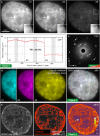SIMcheck: a Toolbox for Successful Super-resolution Structured Illumination Microscopy
- PMID: 26525406
- PMCID: PMC4648340
- DOI: 10.1038/srep15915
SIMcheck: a Toolbox for Successful Super-resolution Structured Illumination Microscopy
Erratum in
-
Erratum: SIMcheck: a Toolbox for Successful Super-resolution Structured Illumination Microscopy.Sci Rep. 2016 Feb 5;6:20754. doi: 10.1038/srep20754. Sci Rep. 2016. PMID: 26847150 Free PMC article. No abstract available.
Abstract
Three-dimensional structured illumination microscopy (3D-SIM) is a versatile and accessible method for super-resolution fluorescence imaging, but generating high-quality data is challenging, particularly for non-specialist users. We present SIMcheck, a suite of ImageJ plugins enabling users to identify and avoid common problems with 3D-SIM data, and assess resolution and data quality through objective control parameters. Additionally, SIMcheck provides advanced calibration tools and utilities for common image processing tasks. This open-source software is applicable to all commercial and custom platforms, and will promote routine application of super-resolution SIM imaging in cell biology.
Conflict of interest statement
The authors declare no competing financial interests.
Figures




References
-
- Hell S. W. Far-field optical nanoscopy. Science 316, 1153–1158 (2007). - PubMed
-
- Zhang J., Campbell R. E., Ting A. Y. & Tsien R. Y. Creating new fluorescent probes for cell biology. Nat Rev Mol Cell Biol 3, 906–918 (2002). - PubMed
-
- Heintzmann R. & Cremer C. Laterally modulated excitation microscopy: improvement of resolution by using a diffraction grating. in Proc SPIE (Bigio, I. J. et al.) 3568, 185–196 (SPIE, 1999).
Publication types
MeSH terms
Grants and funding
LinkOut - more resources
Full Text Sources
Other Literature Sources

